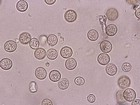Eimeria spp.
| Eimeria spp. | |
|---|---|
| Class | Sporozoasida |
| Order | Eucoccidiarida |
| Family | Eimeriidae |
| Genus | Eimeria |
Introduction
Eimeria spp. us the largest of the genus in the family Eimeriidae, and affects a large number of the domestic species found within the UK.
Each sporulated oocyst has 4 sporocysts, each containing 2 sporozoites. The life cycles are direct, and transmission is via the faecal-oral route.
Eimeria praecox
Eimeria praecox affects chickens. The oocysts are colourless, and around 20μm in length. The endogenous stages occur in the villi. There are usually three stages of merogony, but there may be more. Then both sexual and asexual development occurs, and may be seen together. The prepatent period is around 84 hours.
Eimeria tenella
E. tenella affects chickens. The occysts are ovoid, and colourless, measuring around 20μm in length. The chicken ingests the oocysts, and breaks down the wall, releasing the sporocysts. These then become sporozoites upon entering the small intestine. The sporozoites become merozoites, which enter the caecum, and develop into micro- and macrogametes, which produce eggs. The eggs are then past in faeces by the host. The prepatent period is 132 hours.
Eimeria brunetti
E. brunetti is found in chickens. The oocysts are ovoid and measure 15-30μm in length. The first generation meronts are found in the base of the villi of the intestine. The second generation are found on the tips of the villi, and the third are found in the large intestine. The prepaten period is around 120 hours.
Eimeria mitis
E. mitis affects chickens. The oocysts are 10-20μm in length. The endogenous stages are found in the villi or the crypts of the small intestine, caecum and rectum. The number of meront stages is currently unknown. The asexual and sexual stages occur together, and the prepatent period is around 91 hours.
Eimeria acerulina
E. acerulina affect chickens. The oocysts are ovoid and around 15μm in length. The oocysts are ingested and broken down during digestion, releasing sporocysts. These enter the small intestine where they become sporozoites, and subsequently enter the duodenum.
The meronts are found in the villi of the small intestine, and the sexual stages are found in the host cell nucleus of the epithelial cells. The prepatent period is 89 hours.
Test yourself with the Coccidia Flashcards
| This article is still under construction. |
